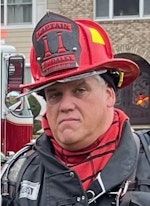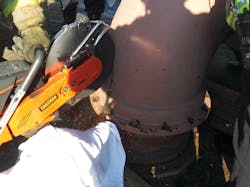Unorthodoxed Confined Space Rescue Challenges NJ Responders
Fire and rescue crews spent more than three hours trying to rescue a man who found himself stuck at the bottom of a pipe at a New Jersey water treatment plant.
On the morning of Jan. 17, 2014, operations were just starting to ramp up at the United Water water treatment facility in Manalapan, NJ. Shortly after 7:00 a.m., an employee overheard someone shouting for help as he was walking the perimeter of the facility. He and a few other workers were able to identify the source of these pleas for help; a man had climbed into a 20-inch diameter pipe that serves as an outflow pipe from a storage facility on site. The pipe empties into a drainage basin at the facility. The victim entered the basin, then the first section of piping, and traversed the horizontal pipe section until he entered a vertical section. He dropped 12 feet underground at the bottom of the pipe, head first. Immediately, workers rushed to summon help at the facility.
The Initial Response
Upon receipt of the initial alarm, the communications center dispatched Manalapan Township Fire Co. 1 and Englishtown-Manalapan Volunteer Rescue Squad. After establishing command and completing a thorough size-up, the decision was made to reach out to the closest rescue team. At 7:35 a.m., command requested a response from the Monroe Township Confined Space Rescue Service. Contact was made with the administrative staff at fire headquarters, who organized a response from Monroe Township that included all three fire districts, along with an ambulance from Monroe EMS.
Additionally, there was potential for a significant injury to the victim; the victim’s travel through the pipe resulted in a 12-foot head first fall down the vertical pipe, outside temperatures during the incident were in the high 30s, and the bottom of the cast iron pipe Tee where the victim was located contained a mixture of water and silt, which could result in thermal injuries to the victim (see Photo 1). Based on the potential victim condition, paramedics on scene made a request for a medi-vac helicopter to stand by the incident for victim transport to the closest trauma center, along with a trauma physician on-scene for initial treatment.
Formulating the Rescue Plan
Once the rescue team arrived on scene, they were led to the location of the pipe where the victim was. Monroe Township District 3’s officer would serve as the initial Operations Officer for victim removal, as the responding chief officer relocated to the command post to serve as a liaison between the rescue operation and the command staff.
It became apparent early into the operation that any success would require the first sections of the pipe assembly to be removed, to allow direct overhead access into the victim, and would make removal of the victim easier than manipulating the victim through the pipes. This plan would require some essential assistance, so a request was made by command at 8:35 a.m. to have New Jersey USAR Task Force 1 (NJ-TF1) respond to the scene to assist with the rescue. NJ-TF1 serves as a full scale Urban Search and Rescue Team (USAR) for the entire state, and has significant expertise in many aspects of technical rescue
Initial Challenges
With additional rescue personnel responding, on-scene operations focused on pipe removal for the entry. The location of the space posed a few problems; the pipe extended upwards from a berm that provided a support wall for the retention basin. The proximity to the basin made for muddy soil around the pipe, which made tool stabilization and operation from the ground level difficult. Secondly, the top of the berm meant that there was limited space for rescuers to operate, and equipment on top of the berm was limited to what was in use at that time. Additionally, finding a suitable overhead anchor for the operation would prove to be limiting. The pitch of the walls around the pipe would not allow mounting a rigid overhead anchor with significant stability, so an overhead anchor from an aerial device was to be used.
Upon arrival of the USAR and UASI rescue teams, a briefing was held at the command post where blueprints for the pipe layout were reviewed. Layouts of the pipe system and victim location were identified and representatives from the rescue teams met with the Operations Officer at the top of the pipe to aid in the rescue. As the pipe sections were removed, operations were underway to improve conditions within the space for the victim; voice contact with the victim was continuing, warm ventilation was being put in place to keep fresh air in the space and increase the temperature within the pipe, and atmospheric monitoring was ongoing to make certain conditions did not change during the operation.
The last elbow of pipe was proving to be a formidable opponent; years of exposure to the elements and to moisture had seized the sections of pipe together at the expansion joint. A decision was made to put a relief cut in the pipe at the joint to relieve the pressure on the pipe. A gas-powered rotary saw was brought up to the pipe and cutting operations began. During the cut, a considerable increase in carbon monoxide (CO) was identified in the space, so the gas powered tools were replaced with an electric reciprocal saw to finish the cut. Once the cut was made, the pipe sections were separated, exposing a 20-inch entry portal to access the victim.
Entry Mode
As the last section of pipe was being removed, crews at the top of the space were transitioning into entry mode. Entrants stood by in harnesses and supplied air respirators (SAR) waiting to be lowered while crew continued to build rigging on top of a tripod that was set up at the equipment staging area. Once the pipe was exposed, almost two feet of pipe extended above the soil line (see Photo 3), limiting the lift capabilities of the rigging system while attached to the tripod. Instead, crews attached the rescue rigging to the tower ladder that was extended over the retention basin to serve as an overhead anchor for the rope systems.
While the rigging was being set into place, rescuers continued to communicate with the victim, providing direction to allow the victim to get himself into position for removal from the pipe. Once the victim was in position, towels and blankets were lowered to the victim to allow him to clean himself up and help keep him warm while in the pipe. A harness was lowered to the victim on the retrieval system, and rescuers were able to direct him in donning the harness on his own. Once the harness was in place, the rope was attached to the haul system and the victim was removed from the pipe.
Victim Removed
EMS personnel were directed up to the entry point of the pipe in order to receive the victim once he was removed from the space. At 10:59, the victim was removed from the space, placed on a backboard and transferred onto a stretcher once he was carried down the basin wall.
The Middlesex County Hazardous Materials Team was on scene as well to provide decontamination efforts while paramedics and the on-scene trauma physician began to evaluate the victim’s condition.
By 11:20, the victim was transported to the landing zone, loaded onto a waiting medi-vac helicopter, and flown to the nearest trauma center for treatment. At 11:42, command was terminated and all resources were cleared from the scene.
Lessons Learned
Considering the complexity and the dynamics of the incident, a few points were raised for consideration and remediation:
Have a resource list developed prior to the incident: Responding officers begin their size-up from the initial dispatch, during the response, and while on-scene. The size-up process identifies needs and resources that will be utilized during the incident. These resources are not limited to rescue personnel; other resources included blueprints for the pipe layout of the facility, as well as equipment operators. Once identified, rapid notification and dispatch of these units are imperative for the highest probably of success. Departments should have a list of resources available to limit the reflex time necessary to get them to the incident.
Access to the space may not be initially accessible: Responders were unable to access entry into the pipe the same way the victim did, and remove the victim once they were packaged. However, this situation is not rare; many times, additional steps are necessary to gain access into the space to perform the rescue. It is imperative that rescuers be trained not only in the steps of the entry and removal, but also possesses the skills necessary to move large objects (see Photo 4), remove significant components and “solve problems” that would hinder an entry to perform rescue.
Develop the skills needed to prepare for any response: Brute strength and hasty actions are no match for mastery of skill. To truly maximize the time spent without waste during an operation, responders shall be experts in the skills needed to perform their duties.
Technical rescues and high-risk operations are time-driven: Limiting the time of exposure for both the rescuers and the victims assures successful outcomes. The best way to limit the time of exposure is to have a mastery of one’s responsibilities at the incident.

Michael Daley
MICHAEL DALEY, who is a Firehouse contributing editor, is a 37-year veteran who serves as a captain and department training officer in Monroe Township, NJ. He is a staff instructor at multiple New Jersey fire academies and is an adjunct professor in the Fire Science Program at Middlesex County College. Daley is a nationally known instructor who has presented at multiple conferences, including Firehouse Expo and Firehouse World. His education includes accreditations as a Chief Training Officer and a Fire Investigator, and he completed the Craftsman Level of education with Project Kill the Flashover. Daley is a member of the Institution of Fire Engineers and a FEMA Instructor and Rescue Officer with NJ Urban Search and Rescue Task Force 1. He operates Fire Service Performance Concepts, which is a training and research firm that delivers and develops training courses in many fire service competencies.






